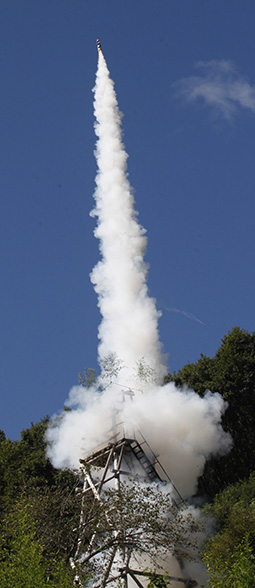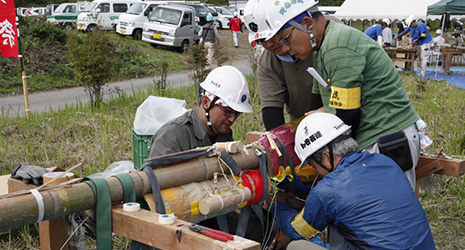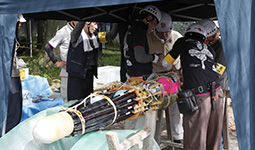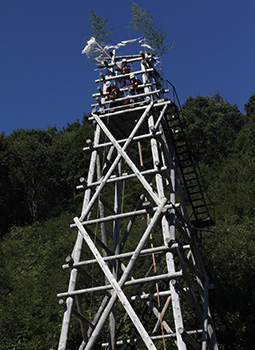February 2020
The Dragon Ascends!

In Chichibu City, Saitama Prefecture, the tradition of making and launching Ryusei rockets has continued for more than 400 years.
Ignited at the top of a 25-meter-tall launch tower, a Ryusei rocket flies off high into the sky letting out a great sound and leaving a trail of thick white smoke. Once it reaches a height of 300 meters, the parachute opens with a bang, and the rocket slowly begins to fall. At that moment, cheers and applause ring out from a gallery of nearly 100,000 spectators.
Ryusei are handmade rockets, the manufacturing techniques for which have been passed down from generation to generation among the people of the Yoshida area of Chichibu City, Saitama Prefecture, for about 400 years. The name “Ryusei” means “ascending dragon,” the ryu being the dragon of Japanese legend.

On the second Sunday of October every year, Ryusei are launched as a Shinto ritual in an annual festival at Chichibu’s Muku Shrine. In 2018, the ritual was designated as a national important intangible folk-cultural property.

According to Hasegawa Kiyomi, vice president of the Society for the Preservation of Ryusei-Festival in Yoshida, “there are several areas in Japan where traditional handmade rockets have continued to be made. Ryusei from the Yoshida area of Chichibu are the only ones where everything has continued to be made by hand, all the way down to the mixing of the gunpowder which acts as fuel, without relying on professionals. This and the fact that the ancient method for making Ryusei by hand, passed down by oral tradition, has been preserved are some of the main reasons that it was designated as a national cultural asset.”

Ryusei are made up of three large components. First, is the yagara (shaft), made from dried green bamboo that was cut in winter. It is about 18 meters long, and has the role of stabilizing Ryusei’s flight. The shoimono (carried items) are the paper umbrella, fireworks, parachute and other mechanisms set up at the end of the yagara, and fastened below that is the kayakutou (gunpowder tube). According to Kato Goro, a staff member of the Preservation Society and follower of the Jyoumine zuiunryuu school of the Ryusei tradition, “the construction is just as it was in the past, and in principle, it is the same as solid fuel rockets. This is why a person from NASA (National Aeronautics and Space Administration) who looked at materials on Ryusei said, ‘if scientists had known about Ryusei, our progress with rockets would’ve been ten years faster’.”
Currently, twenty-five schools are active, each with ten to thirty members. On the day of the annual festival at Muku Shrine, thirty Ryusei rockets are launched at 15-minute intervals, with the shoimono differing according to the school.
Not all Ryusei launches are successful. Some do not rise into the air, and sometimes the top of the launch tower explodes. This makes the success of a perfect launch all the more joyous, and there are more than a few members who involuntarily burst into tears.
Even though the Ryusei of the Yoshida area bring excitement each year, the issue of lack of successors has become a problem. Gathering all the members of each school and working together has become difficult as the declining birthrate and aging population progress, the number of full-time farmers decreases, and most people leave the area to work in the city. At the same time, the Preservation Society is putting effort into outreach programs at schools. For two hours per week over about five months, lessons on creating parachutes for Ryusei, carving pipes for gunpowder, and more have been held at Yoshida Elementary School since 2003 and at Yoshida Junior High School since 2010.
“Because we handle gunpowder, you have to be 18 to become a member,” says Hasegawa, “but in the past, people who would later become members began to appear from among the kids that I taught at my elementary school. I’m really happy when someone calls out to me at meetings and other times, saying, ‘Long time no see, Ms. Hasegawa!’”
At Michi no Eki Ryusei Kaikan in the Yoshida area, films of Ryusei launches are shown on a large screen alongside exhibits of Ryusei and the towers used for launches. Local people are coming together to work on outreach programs so that there is a future for the tradition of handmade rockets.


